If you found our recent photo gallery of the European market 2012 Honda Civic at the 64th Frankfurt Motor Show somewhat lacking in quantity, you’ll be happy to know that the Japanese carmaker has just dropped more than 140 high resolution pictures of the hatchback model for your viewing pleasure.
Honda claims that its new Civic hatchback is a great leap forward not only for the company but for the European C-segment as well, something that is echoed in the latest statements from the car’s project leader, Mitsuru Karita.
“When evaluating the requirements of our customers, we recognized that the European customer desires are demanding and unique in many aspects”, said Karita. “We have focused our development on fulfilling these expectations and, through this process, we have taken our development standards even further to a new level.”
In its four-year development period, Karita-san and his team decided to build on the previous model’s strengths and improve on certain core aspects: reduce emissions, make it more cost efficient and Eco-friendly, improve ride and handling, upgrade interior quality and refine the exterior styling.
At launch, the European Civic is available with two i-VTEC petrol engines with a displacement of 1.4-liters and 1.8-liters producing 100HP and 142HP respectively, plus a 2.2-liter common-rail turbodiesel with 150HP and an average fuel consumption of just 4.2 lt/100 km (54.7 mpg US).
Along with the new photo gallery, Honda also reminded us of the European Civic’s eight previous generations which combined, have sold more than 20 million units worldwide. You can check them out both below.
[From Honda Press Release]
1st Generation (1972-1979)
The Civic was launched as Honda’s vision of an affordable yet comfortable and fun to drive car. It was the first car in the world to pass the pioneering US ‘Muskie’ Clean Air Act and achieved the highest fuel economy ratings issued by the US Environmental Protection Agency for four successive years.
2nd Generation (1979-1983)
Sales of the Civic passed the 2.5 million milestone. 3, 4 and 5-door versions were sold in all the major markets and engines ranged from 1.3 to 1.5 litres. The CVCC engine was further developed for even higher combustion efficiency and a catalytic converter was also added.
3rd Generation (1983-1987)
The ‘Wonder Civic’ evolved around a design concept called ‘Man-Maximum, Machine Minimum’, with the customer as the focus and served by the vehicle.
4th Generation (1987-1991)
This Civic saw the introduction of four-valve-per-cylinder engines across all models. For the first time the double wishbone suspension system used on the Accord and Prelude was incorporated front and rear for excellent stability and handling. The DOHC VTEC was the first engine in the world to electronically control both valve timing and lift.
5th Generation (1991-1995)
Aerodynamics and economy were key elements behind the 5th generation Civic. The engine line-up included 1.3, 1.4, 1.5 and 1.6-litre units. The acclaimed VTEC technology was also applied to the SOHC engine, thus further enhancing the balance between fuel economy and performance. Further developments came with VTEC-E which was geared towards improved fuel efficiency. Civic production passed the 10 million mark during this period.
6th Generation (1995-2000)
This Civic was a top seller with over 3.2 million units built. Available in 2, 3, 4, and 5-door variants the 6th generation engine choice included the Civic’s first diesel – a 2.0-litre. The petrol choice was between 1.3, 1.4, 1.5, 1.6 and 1.8-litre capacities.
The possibility of improving engine output without adversely affecting fuel consumption was clearly demonstrated by the three-stage VTEC engine. CVT transmission offered stepless, automatic gear changing for the first time.
7th Generation (2000-2005)
Two million 7th generation Civics were produced between 2000 and 2005, featuring a more spacious interior, a totally new flat floor and a dashboard-mounted gear lever.
By coupling VTEC with VTC (Variable Timing Control), Honda engineers created better performing engines. Growing environmental concerns led to the creation of the Civic IMA (Integrated Motor Assist). An electric motor coupled to a frugal i-DSI engine generated something very unique: a 1.3-litre engine with fuel efficiency similar to a 1.0-litre engine and with the performance of a 1.6-litre engine.
This generation saw Honda introduce their first Civic Hybrid, powered by a 1.3 litre engine. In terms of safety the Civic had been awarded the highest ever score by Euro NCAP for pedestrian safety (old protocol).
8th generation (2006-2011)
For the 2006 generation Honda split the model into two different platforms, one primarily for the home market and North America and the other designed for the European market.
The European version is available with a 1.8-litre i-VTEC, a 1.4-litre i-DSI or a powerful and economical 2.2-litre diesel engine. It excelled in blending good handling and performance with a spacious interior and impressive fuel efficiency. In 2009 the Civic was updated with a fresh look, a new, economical 1.4-litre i-VTEC engine and bespoke automatic transmission. Since 1973, more than 20 million Civics have been sold worldwide.
PHOTO GALLERY
























































































































































